(!)NOTE : Windows 7 users won’t be able to use some latest features of eCatalog/WOS since Microsoft is ending support for Windows 7 on 14 Jan, 2020. Please upgrade your system for uninterrupted services.
- Please note that the MISUMI India offices and warehouses will remain closed from Oct 31st to Nov 3rd due to the Diwali festival.
Please note that the MISUMI Pune office and warehouse will be closed on November 20th due to the state election. - Notice of End of Sales for Economy Series Pneumatic Equipment Category. More information.
Cables with Square Connectors(Hood:NA)
Brand |
|
|---|---|
| CAD |
|
3 items
- Sort By
-
You can add up to 6 items per a category to the compare list.
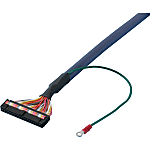
Generic Cable with Press-fit Connector
MISUMI
Harness that is widely used in FA equipment
- CAD :
- 2D
Connector type Number Of Cores Connector manufacturer CN1 CN2 Connector Shape Cable shape Machining Method Hood Hood screw MIL 10 ~ 64W Hirose Electric Male / Female Male / Female / Discrete Wire / Y Shape Terminal / Cut off Straight Round Pressure Welding NA - Days to Ship: 7 Day(s) or more  7 Day(s) or more
7 Day(s) or more
-
You can add up to 6 items per a category to the compare list.
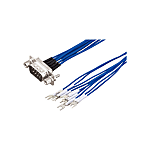
Serial Discrete Wire Cable with D-Sub Hooded Connector (with Misumi Original Connector)
MISUMI
All-time-low price in same series additional significant discount for 20 pieces or more
Connector type Number Of Cores Connector manufacturer CN1 CN2 Connector Shape Cable shape Machining Method Hood Hood screw Dsub 9 ~ 37 MISUMI Male Discrete Wire / Y Shape Terminal / Cut off Straight Discrete Wire Solder NA M2.6 Hex lock nut / #4-40 Hexagon head lock nut Days to Ship: 8 Day(s) or more  8 Day(s) or more
8 Day(s) or more
-
You can add up to 6 items per a category to the compare list.

Serial Discrete Wire Cable without D-Sub Hooded Connector (with DDK Connectors)
MISUMI
All-time-low price in same series additional significant discount for 20 pieces or more
Connector type Number Of Cores Connector manufacturer CN1 CN2 Connector Shape Cable shape Machining Method Hood Hood screw Dsub 9 ~ 37 DDK Ltd. Male / Female Discrete Wire / Y Shape Terminal / Round Terminal / Cut off Straight Discrete Wire Solder NA M2.6 Hex lock nut / #4-40 Hexagon head lock nut Days to Ship: 8 Day(s) or more  8 Day(s) or more
8 Day(s) or more
| Brand |
|---|
| Product Series |
| CAD |
| From |
| Days to Ship |
| Specifications |
| Connector type |
| Number Of Cores |
| Connector manufacturer |
| CN1 |
| CN2 |
| Connector Shape |
| Cable shape |
| Machining Method |
| Hood |
| Hood screw |
You can add up to 6 items per a category to the compare list. | You can add up to 6 items per a category to the compare list. | You can add up to 6 items per a category to the compare list. | |
| Brand | MISUMI | MISUMI | MISUMI |
| Product Series | Serial Discrete Wire Cable with D-Sub Hooded Connector (with Misumi Original Connector) | Serial Discrete Wire Cable without D-Sub Hooded Connector (with DDK Connectors) | |
| CAD |
| ||
| From | |||
| Days to Ship | 7 Day(s) or more | 8 Day(s) or more | 8 Day(s) or more |
| Specifications | |||
| Connector type | MIL | Dsub | Dsub |
| Number Of Cores | 10 ~ 64W | 9 ~ 37 | 9 ~ 37 |
| Connector manufacturer | Hirose Electric | MISUMI | DDK Ltd. |
| CN1 | Male / Female | Male | Male / Female |
| CN2 | Male / Female / Discrete Wire / Y Shape Terminal / Cut off | Discrete Wire / Y Shape Terminal / Cut off | Discrete Wire / Y Shape Terminal / Round Terminal / Cut off |
| Connector Shape | Straight | Straight | Straight |
| Cable shape | Round | Discrete Wire | Discrete Wire |
| Machining Method | Pressure Welding | Solder | Solder |
| Hood | NA | NA | NA |
| Hood screw | - | M2.6 Hex lock nut / #4-40 Hexagon head lock nut | M2.6 Hex lock nut / #4-40 Hexagon head lock nut |
Loading...
Configure
Specification/Dimensions
-
Connector type
- Dsub
- MIL
- FCN
- Centronics
- IEEE
- PCR
- FCN/MIL
- Other
-
Number Of Cores
-
Connector manufacturer
- MISUMI
- DDK Ltd.
- Omron
- Hirose Electric
- Fujitsu
- Sumitomo 3M
- Honda Tsushin Kogyo
- Fujitsu/Hirose
-
CN1
- Male
- Female
-
CN2
- Male
- Female
- Discrete Wire
- Y Shape Terminal
- Round Terminal
- Cut off
- Fusion
-
Connector Shape
- Straight
- Angle
-
Cable shape
- Round
- Flat
- Discrete Wire
-
Machining Method
- Solder
- Pressure Welding
- Crimp
-
Hood
- EMI-compatible plastic
- EMI-compatible metal
- Metal
- Plastic
- Diecast
- NA
- General-Purpose Resin
-
Hood screw
- M2.6 short screw
- M2.6 screw lock
- M2.6 Hex lock nut
- M3.5 screw lock
- #4-40 Short screw
- #4-40 Hexagon head lock nut
- Single-Action
Related Categories to Cables with Square Connectors
FAQ Cables with Square / Rectangular Connectors
- Question: What types of electrical systems can be connected using cables with rectangular connectors?
- Answer: Rectangular connectors can be used to connect various types of electrical systems. They are suitable for a wide range of applications, such as
1. Industrial Control Systems: They are frequently used to connect components of control systems, sensors, and actuators. They play a crucial role in linking devices for automation and control.
2. Computer and Data Systems: They are commonly used in computer systems and data applications to connect various peripherals such as hard drives, printers, and external devices.
3. Robotics and Automation:In robotics and automation, rectangular connectors are commonly used to connect various sensors, motors, and control components.
These connectors are available in different sizes, pin versions, and materials, making them suitable for use in industrial environments, and high-speed data center and networking equipment - Question: How do rectangular connectors ensure secure electrical connections in industrial machinery?
- Answer: Rectangular connectors ensure secure electrical connections in industrial machinery through their robust construction, which makes them suitable for harsh environments. They provide a secure and insulated connection, minimizing the risks of electrical shock, short circuits, and fires, and they are made of durable materials like copper or aluminum, offering excellent conductivity and resistance to corrosion thus contributing significantly to safety in power distribution systems. These connectors are designed for rugged applications such as industrial robotics and machinery equipment
- Question: In what ways do D-Sub connectors facilitate computer and monitor connections?
- Answer: D-Sub connectors, also known as VGA connectors, facilitate computer and monitor connections in various ways. They are widely employed for linking devices like monitors, printers, and serial ports to computers. When utilized as a monitor interface, a D-Sub port, or VGA port, provides an analog connection standard that is compatible with a large number of PCs and LCD monitors. It is important to note that D-Sub connectors are analog, and for the best video quality, digital signals such as HDMI or DVI, nowadays HDMI and DVI are preferred over the D-Sub connection
- Question: What considerations are important for electrical system connections in power systems?
- Answer: When considering electrical system connections in power systems, several important factors should be taken into account to ensure
1. Contact Resistance: Low contact resistance ensures efficient power transmission.
2. Reliability: Choose connectors that ensure a stable and consistent power supply.
3. Energy Conservation: Opt for connectors that minimize energy losses.
4. Compatibility: Ensure connectors meet specific requirements and standards.
5. Environmental and Temperature Durability: Select connectors that can withstand harsh environmental conditions and operate reliably across temperature variations.
6. Voltage Ratings: Connectors must handle maximum voltage without insulation failure for example burn - Question: What are the benefits of using EMI Countermeasures in cable designs for signal protection?
- Answer: EMI (Electromagnetic Interference) countermeasures in cable designs offer several benefits for signal protection:
1. Reduced vulnerability to EMI: Shielded cables can protect against both emitting and receiving EMI, reducing the risk of interference and ensuring reliable communication
2. Improved performance: As electronic devices become more complex and operate at higher frequencies, they generate more electromagnetic noise. EMI suppression filters (EMIFIL) can help mitigate this noise, improving the performance of electronic devices
3. Protection against external interference: EMI shielding can help protect electronic devices from unwanted electric currents induced by external electromagnetic waves




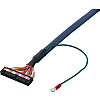
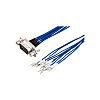
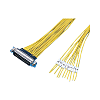



How can we improve?
How can we improve?
Thank you for your time.
Your feedback is essential for our continuous improvement
Privacy Policy
Thank you for your cooperation.
Thank you for your time.
Your feedback is essential for our continuous improvement
Please use the inquiry form.
Privacy Policy